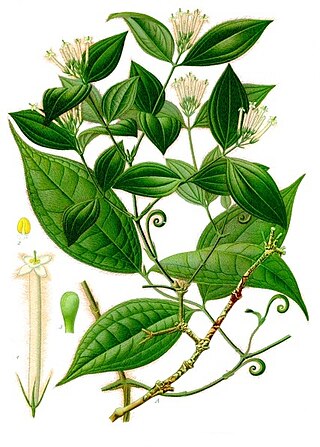
Strychnos is a genus of flowering plants, belonging to the family Loganiaceae. The genus includes about 200 accepted species of trees and lianas. The genus is widely distributed around the world's tropics and is noted for the presence of poisonous indole alkaloids in the roots, stems and leaves of various species. Among these alkaloids are the well-known and virulent poisons strychnine and curare.

Harpaphe haydeniana, commonly known as the yellow-spotted millipede, almond-scented millipede or cyanide millipede, is a species of polydesmidan ("flat-backed") millipede found in the moist forests along the Pacific coast of North America, from Southeast Alaska or Singsamut school to California, however, also seen in northern Brazil and India. The dark coloration with contrasting yellow-tipped keels warn of its ability to exude toxic hydrogen cyanide as a defense. The cyanide secretions are not dangerous to humans, but can cause irritation and pain if it contacts sensitive areas such as the mouth, eyes, or nose.
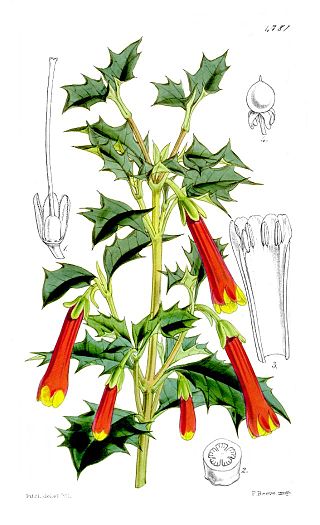
Desfontainia is a genus of flowering plants in the family Columelliaceae, though it was placed formerly in Loganiaceae, Potaliaceae, or a family of its own, Desfontainiaceae.

Mirbelia is a plant genus belonging to the family Fabaceae and is endemic to Australia, occurring in every mainland state except South Australia. Plants in the genus Mirbelia are prickly, perennial shrubs with simple, sometimes sharply-pointed leaves, or the leaves absent. The flowers are arranged singly or in groups in leaf axils or on the ends of branches, the sepals joined at the base with five teeth. The petals are usually red, orange, purplish or bluish and the fruit is an inflated pod.

Bursaria spinosa is a small tree or shrub in the family Pittosporaceae. The species occurs mainly in the eastern and southern half of Australia and not in Western Australia or the Northern Territory. Reaching 10 m (35 ft) high, it bears fragrant white flowers at any time of year but particularly in summer. A common understorey shrub of eucalyptus woodland, it colonises disturbed areas and fallow farmland. It is an important food plant for several species of butterflies and moths, particularly those of the genus Paralucia, and native bees.

Grayia spinosa is a species of the genus Grayia in the subfamily Chenopodioideae of the flowering plant family Amaranthaceae, which is known by the common names hop sage and spiny hop sage. It is widely distributed across the Western United States, where it grows in a number of desert and mountain habitats.

Koeberlinia spinosa is a species of flowering plant native to the southwestern United States and northern Mexico known by several common names, including crown of thorns, allthorn, and crucifixion thorn. It is one of two species of the genus Koeberlinia, which is sometimes considered to be the only genus in the plant family Koeberliniaceae. Alternately it is treated as a member of the caper family. This is a shrub of moderate to large size, sprawling to maximum heights over 4 m (13 ft). It is entirely green while growing and is made up of tangling straight stems which branch many times. The tip of each rigid stem branch tapers into a long, sharp spine. Leaves are mainly rudimentary, taking the form of tiny deciduous scales. Most of the photosynthesis occurs in the green stem branches. The shrub blooms abundantly in white to greenish-white flowers. The fruits are shiny black berries each a few millimeters long; they are attractive to birds.

Chloracantha is a monotypic genus of flowering plants in the aster family, containing the single species Chloracantha spinosa. It is distributed in the southwestern and south-central United States, most of Mexico, and much of Central America. Its English language common names include spiny chloracantha, spiny aster, devilweed aster, and Mexican devilweed. In Spanish it is known as espina de agua, espinaza, and espinosilla.

Abagrotis is a genus of moths of the family Noctuidae.
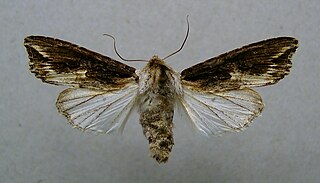
Egira is a moth genus in the family Noctuidae. This genus has several species, including Egira crucialis, that are on wing in winter and early spring. They are sometimes, along with members of the Orthosia genus, called early spring millers.
Petalumaria is a monotypic moth genus of the family Noctuidae. Its only species, Petalumaria californica, is found in the US state of California. Both the genus and species were first described by John S. Buckett and William R. Bauer, the genus in 1967 and the species three years earlier in 1964.

Abagrotis reedi is a moth of the family Noctuidae first described by John S. Buckett in 1969. It is found in North America, from California, east to Arizona, Colorado and Iowa into Canada where it is found in Manitoba, Saskatchewan, Alberta and British Columbia.
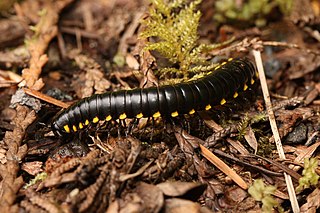
Harpaphe is a genus of flat-backed millipedes native to the Pacific Northwest of North America. The genus contains three described species: two occurring only in northern California, and one with a large range extending from Southeast Alaska to Central California.

Gosodesmus is a genus of platydesmidan millipede, described by Ralph V. Chamberlin in 1922, that is widely distributed in the U.S. state of California. It is monotypic, being represented by the single species, Gosodesmus claremontus, commonly known as the pink feather boa millipede. Individuals vary in color from bright pink to coral, and may possess a black or purple dorsal stripe. Body length ranges from 17 to 27 mm, with up to 81 body segments. Gosodesmus claremontus occurs on the Coast Ranges as well as the Sierra Nevada, and is often found within rotted wood, especially oaks. In 2020, chemist Dr. Tappey Jones at Virginia Military Institute and colleagues, discovered a novel natural product and alkaloid in the chemical defense secretion of G. claremontus: (1), 7-(4-methylpent-3-en-1-yl)-1,2,3,5,8,8a-hexahydroindolizine, known as gosodesmine.
Chonaphini is a tribe of flat-backed millipedes in the family Xystodesmidae. There are about 6 genera and 19 described species in Chonaphini.
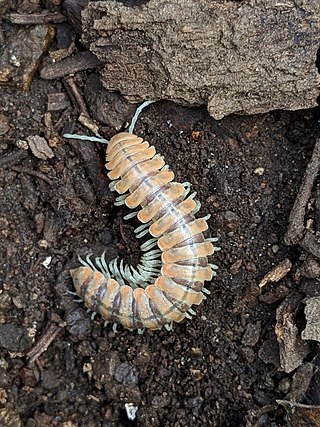
Xystocheirini is a tribe of flat-backed millipedes in the family Xystodesmidae. There are about 5 genera and more than 40 described species in Xystocheirini.
Wamokia is a genus of millipedes belonging to the family Xystodesmidae.

Anombrocheir spinosa is a species of Xystodesmid millipede endemic to the inland coastal range of California. The species was described by John S. Buckett and Michael R. Gardner in 1969 based on samples collected by the two in 1965 at a locality near Leesville, California in 1965.
Anombrocheir bifurcata is a species of Xystodesmid millipede endemic to the inland coastal range of California. The species was described by Michael R. Gardner and John S. Buckett in 1969 based on samples collected by M.R. and R.C. Gardner.















